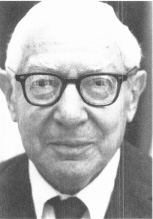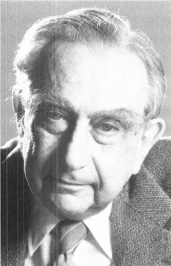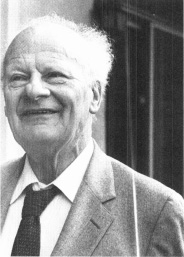Pandora's Keepers (29 page)
Authors: Brian Van DeMark

A chastened and reflective Robert Oppenheimer after the revocation of his security clearance, late 1950s. His story was a
personal tragedy—and the tragedy of his generation of physicists, who opened Pandora’s box and ushered nuclear weapons into
the world. (
AIP Emilio Segrè Visual Archives
, Physics Today
Collection
)

I. I. Rahi at the fortieth anniversary commemoration of the founding of the Los Alamos National Laboratory, 1983. At the commemoration,
Rabi spoke with conscious and courageous irony of “how well we meant.” He died in 1988. (
Photograph by Sam Treiman, courtesy AIP Emilio Segrè Visual Archives
, Physics Today
Collection
)

Edward Teller in his eighties, in a photograph taken in his office at the Hoover Institution in Stanford, California, where
he continued in interviews to voice the argument for nuclear weapons well into his nineties. (©
Roger Ressmeyer/CORBIS
)

An insecure pessimist, Edward Teller found refuge from his anxieties at the piano, where he played sonatas by Mozart and Beethoven.
(
Photo by Fred Rothwarf, courtesy AIP Emilio Segrè Visual Archives
)

Hans Bethe in his nineties, the grand old man of American physics until his death in the early twenty-first century and sharp
critic of the nuclear arms race. Bethe and Teller became two lions contesting the legacy of their momentous creation. (
AIP Emilio Segrè Visual Archives, Segrè Collection
)
Although Stimson sought to create an atmosphere in which everyone felt free to discuss any problem related to atomic energy,
he opened the meeting by reminding Compton, Lawrence, Oppenheimer, and Fermi that he and Army Chief of Staff Marshall were
the ones responsible for making recommendations on military matters to the president. Stimson was anxious, however, to impress
upon them “that we were looking at this like statesmen and not like merely soldiers anxious to win the war at any cost.”
30
To corroborate his point, Stimson read from handwritten notes he had prepared for the meeting:
Its
size
and
character
We don’t think it
mere
new
weapon
Revolutionary Discovery
of Relation of man to universe
Great History Landmark like
Gravitation
Copernican
Theory
But,
Bids fair [to be]
infinitely greater
, in
respect
to its
Effect
—on the ordinary affairs of man’s life.
May
destroy
or
perfect
International
Civilization
May [be]
Frankenstein or
means for World Peace
31
Compton then gave a terrifying seminar on the future of nuclear weapons. He explained that the atomic bombs nearing completion
were only the first step along the road of nuclear weapons technology. In the not too distant future, Compton soberly observed,
loomed the awesome prospect of a “superbomb” perhaps a thousand times more destructive. Oppenheimer then explained how unimaginably
destructive a superbomb would be: an atomic bomb was expected to have an explosive force of 2,000 to 20,000 tons of TNT; a
superbomb might produce an explosive force of 10,000,000 to 100,000,000 tons of TNT. If an atomic bomb could effectively destroy
a city, those present could only wonder in fright at what an explosive force of this magnitude would destroy.
The implication to Lawrence was inescapable: the United States would be in mortal danger if and when another country acquired
such a bomb. Lawrence urged staying ahead of the rest of the world by expanding the weapons lab at Los Alamos and stockpiling
atomic bombs. Compton agreed. Oppenheimer did not, fearing an arms race as soon as the Soviet Union took up the challenge.
The committee then took up the issue of international control. Byrnes asked how long it would take for the Soviet Union to
catch up.
32
Groves estimated at least twenty years. The scientists disagreed, estimating Russia could build a bomb in four to six years.
*
Oppenheimer put the point vividly. “Our monopoly is like a cake of ice melting in the sun,” he said.
33
Drawing on his talks with Bohr at Los Alamos, Oppenheimer urged that Washington contact Moscow promptly about joining in
a system of international control without giving them details of the progress achieved. Marshall agreed, saying it might be
desirable to invite Russian scientists to witness the first atomic bomb test scheduled for July in New Mexico. Byrnes strenuously
objected. He said Stalin would ask to be brought into the project—and that was unacceptable. Byrnes believed the bomb’s diplomatic
utility would be diminished if Stalin was informed of the weapon prior to its use. He favored seeking international control
while maintaining U.S. atomic superiority. Such a strong statement by a man of Byrnes’s influence and prestige was not to
be dismissed lightly. No one challenged him—nor expressed die contradiction between these objectives.
34
Everyone except Marshall then adjourned to a dining room across the hall for lunch. The conferees sat around four tables.
Discussion centered on whether or not to use the bomb against Japan—the
only
time this crucial and fundamental question would ever be formally addressed. Given the bomb’s momentous implications, and
in light of all the subsequent controversy about its use, it is striking how virtually no one in the inner circle of decision
making seriously contemplated not dropping it. To a degree that later generations would find remarkable, the advent of the
nuclear age was heralded by little formal deliberation. Events were in the saddle, and they rode men hard.
The talk was brief, lasting ten minutes. Lawrence repeated a suggestion he had made that morning for a nonmilitary demonstration.
A political naif, he thought the weapon would not actually be used. “The bomb will never be dropped on people,” he had assured
the chairman of Berkeley’s physics department. “As soon as we get it, we’ll use it only to dictate terms of peace.”
35
Compton asked whether it was possible to give the Japanese an opportunity to witness the weapon’s tremendous power before
it was dropped on them. Stimson invited comments. The reaction was negative: the weapon might be a dud; a failure would strengthen
Japan’s morale; if the Japanese received a prior warning, they might take steps to block it; fanatical militarists would be
unimpressed by a demonstration; the Japanese might move American prisoners of war into the test area.
Oppenheimer then reported an estimate prepared at Los Alamos of the number of deaths that would be caused if an atomic bomb
were exploded over a city. (The estimate—twenty thousand—was based on the erroneous assumption that a city’s inhabitants would
seek shelter before the bomb went off.) A participant soberly noted that this number would be no greater than the number killed
in the Tokyo fire raid—far less, in fact. The outcome, Compton later wrote, was that “no one could suggest a way in which
[a demonstration] could be made so convincing that it would be likely to stop the war.”
36
Returning to Stimson’s office after lunch, the participants took up the bomb’s probable impact on Japan’s will to fight. Someone
again observed that its destructive effect might not differ much from the B-29 fire raids incinerating Japan’s cities. Oppenheimer
predicted that the visual effect of the bomb would be “tremendous” and for the first time mentioned radiation, but he did
not mention the possibility of lingering illness.
Stimson expressed the conclusion, on which there was general agreement, that the Japanese should not be given any warning.
He said the bomb should not be dropped on a civilian area, but an attempt should be made to make a profound psychological
impression on as many Japanese as possible. The preferred target would be a war plant closely surrounded by workers’ homes.
None of those present, however, noted the contradiction in their logic: a bomb powerful enough to destroy an entire city would
surely kill thousands—probably tens of thousands—of civilians if dropped anywhere near workers’ homes. Compton, Lawrence,
Oppenheimer, and Fermi perhaps understood this contradiction best because they knew best how destructive the bomb would be,
but at no time did they point it out. Perhaps it was because the four of them felt such views would find little sympathy at
such a meeting. Perhaps it was because they themselves were too invested in the project. Or perhaps it was because they did
not want to admit to themselves what the human costs of their creation’s use would be.
*
But the dilemma that policy makers and scientists preferred not to face was all too real. And it remained on Compton’s mind.
“What shall I tell Szilard?” he asked Oppenheimer as the session broke up. Oppenheimer gave no answer.
37
Stimson informed Truman of the committee’s recommendation on June sixth. The decision to use the bomb was inherent in the
decision made years before to build it. The momentum of that process was rapidly building toward an all but inevitable climax.
Compton returned to Chicago knowing that he faced a growing gulf between the views of the Interim Committee and the Met Lab
scientists under his direction. He reported to his restless constituents on the afternoon of June second, immediately after
his arrival from Washington. Constrained by the secrecy rule that the Interim Committee had imposed on its science advisers,
Compton did not disclose that a recommendation had been made to drop the bomb on Japan without warning. Instead, he told his
audience that the Science Advisory Panel would meet again in mid-June in Los Alamos.
Szilard sat in the audience glumly listening to Compton. His respect for policy makers had hit a new low after his meeting
with Byrnes in Spartanburg. Szilard also lacked confidence in the Scientific Advisory Panel. He believed that Oppenheimer
would not oppose dropping the bomb after laboring so long and hard to make it; that Fermi would state his views privately
but would not speak up; and that Compton would not risk incurring the displeasure of the Washington Establishment. And he
faced the renewed wrath of Groves, who had learned about his unauthorized trip to Spartanburg.